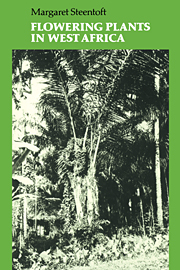Book contents
- Frontmatter
- Contents
- Introduction
- List of symbols and abbreviations
- 1 Species associations
- 2 Vegetation in West Africa
- 3 Annonaceae – soursop family
- 4 Amaranthaceae – amaranth family
- 5 Cucurbitaceae – gourd family
- 6 Ochnaceae – ironwood family
- 7 Combretaceae – afara family
- 8 Guttiferae (Clusiaceae) – butter tree family
- 9 Sterculiaceae – cocoa family
- 10 Bombacaceae – silk cotton family
- 11 Malvaceae – cotton family
- 12 Euphorbiaceae – cassava family
- 13 Caesalpiniaceae – pride of Barbados family
- 14 Mimosaceae – Acacia family
- 15 Papilionaceae – cowpea family
- 16 Ulmaceae – afefe family
- 17 Moraceae – mulberry family
- 18 Meliaceae – mahogany family
- 19 Sapindaceae – akee apple family
- 20 Anacardiaceae – cashew nut family
- 21 Sapotaceae – sheabutternut family
- 22 Apocynaceae – frangipani family
- 23 Asclepiadaceae – blood flower or milkweed family
- 24 Rubiaceae – abura family
- 25 Compositae (Asteraceae) – Tridax family
- 26 Solanaceae – tomato family
- 27 Convolvulaceae – sweet potato family
- 28 Bignoniaceae – jacaranda family
- 29 Acanthaceae – Thunbergia family
- 30 Verbenaceae – teak family
- 31 Labiatae (Lamiaceae) – Hausa potato family
- 32 Commelinaceae – day flower family
- 33 Zingiberaceae – ginger family
- 34 Marantaceae – (West Indian) arrowroot family
- 35 Liliaceae – lily family
- 36 Araceae – cocoyam family
- 37 Palmae (Arecaceae) – palm family
- 38 Orchidaceae – orchid family
- 39 Cyperaceae – sedge family
- 40 Gramineae (Poaceae) – grass family
- General bibliography
- Index of family, generic and common names
6 - Ochnaceae – ironwood family
Published online by Cambridge University Press: 02 November 2009
- Frontmatter
- Contents
- Introduction
- List of symbols and abbreviations
- 1 Species associations
- 2 Vegetation in West Africa
- 3 Annonaceae – soursop family
- 4 Amaranthaceae – amaranth family
- 5 Cucurbitaceae – gourd family
- 6 Ochnaceae – ironwood family
- 7 Combretaceae – afara family
- 8 Guttiferae (Clusiaceae) – butter tree family
- 9 Sterculiaceae – cocoa family
- 10 Bombacaceae – silk cotton family
- 11 Malvaceae – cotton family
- 12 Euphorbiaceae – cassava family
- 13 Caesalpiniaceae – pride of Barbados family
- 14 Mimosaceae – Acacia family
- 15 Papilionaceae – cowpea family
- 16 Ulmaceae – afefe family
- 17 Moraceae – mulberry family
- 18 Meliaceae – mahogany family
- 19 Sapindaceae – akee apple family
- 20 Anacardiaceae – cashew nut family
- 21 Sapotaceae – sheabutternut family
- 22 Apocynaceae – frangipani family
- 23 Asclepiadaceae – blood flower or milkweed family
- 24 Rubiaceae – abura family
- 25 Compositae (Asteraceae) – Tridax family
- 26 Solanaceae – tomato family
- 27 Convolvulaceae – sweet potato family
- 28 Bignoniaceae – jacaranda family
- 29 Acanthaceae – Thunbergia family
- 30 Verbenaceae – teak family
- 31 Labiatae (Lamiaceae) – Hausa potato family
- 32 Commelinaceae – day flower family
- 33 Zingiberaceae – ginger family
- 34 Marantaceae – (West Indian) arrowroot family
- 35 Liliaceae – lily family
- 36 Araceae – cocoyam family
- 37 Palmae (Arecaceae) – palm family
- 38 Orchidaceae – orchid family
- 39 Cyperaceae – sedge family
- 40 Gramineae (Poaceae) – grass family
- General bibliography
- Index of family, generic and common names
Summary
Although there are only five genera in West Africa, three of them are important ecologically. These are trees and shrubs, Ouratea being a large genus (of c. 40 species in West Africa), containing, on a pantropical basis, half the species of the family (c. 300).
Members of the family may be recognised by their alternate, simple, stipulate leaves with prominent, numerous pinnate veins, shallow conspicuous white or yellow flowers (with 10 to numerous stamens) in racemose inflorescences, and by their fruits (see below).
Fleurydora felicis is endemic to West Africa and confined, so far as is known, to Guinée, where it grows as a yellow-flowered shrub or small tree among rocks. The only West African herb of the family, Sauvagesia erecta, is, however, widespread in wet places (also in Gambia), and has solitary, axillary white-to-pink flowers.
Flowers ⊕ 5-part. K5, coloured and/or persistent (caducous in Fleurydora). C5 (sometimes joined basally, Ouratea), contorted (valvate in Sauvagesia). A5 (Fleurydora and Sauvagesia), or 10 (Ouratea), alternating with the petals, or numerous (Lophira and Ochna); the filaments persistent, anthers opening by slits (terminal pores in Lophira, some Ochna spp., Ouratea, Fleurydora). G(2) (Lophira), (3) (Sauvagesia) or (5), uncommonly to (10), deeply lobed in Ochna and Ouratea with a gynobasic style; 1-celled in Lophira (with an intrusive basal placenta with several ovules) and in Sauvagesia with intrusive parietal placentae above, axile placentae below; 5–10-celled otherwise, very deeply lobed with a single basal ovule per cell in Ochna and Ouratea (several axile ovules in Fleurydora).
- Type
- Chapter
- Information
- Flowering Plants in West Africa , pp. 91 - 94Publisher: Cambridge University PressPrint publication year: 1988



